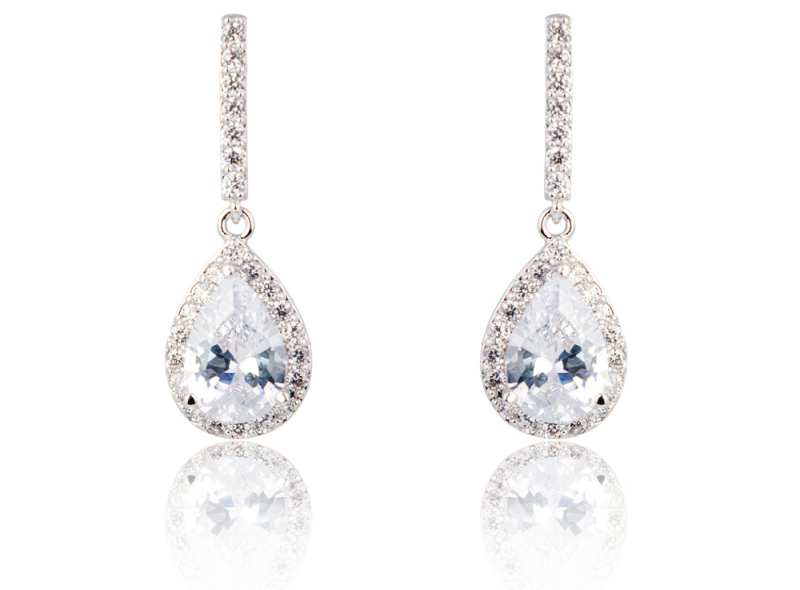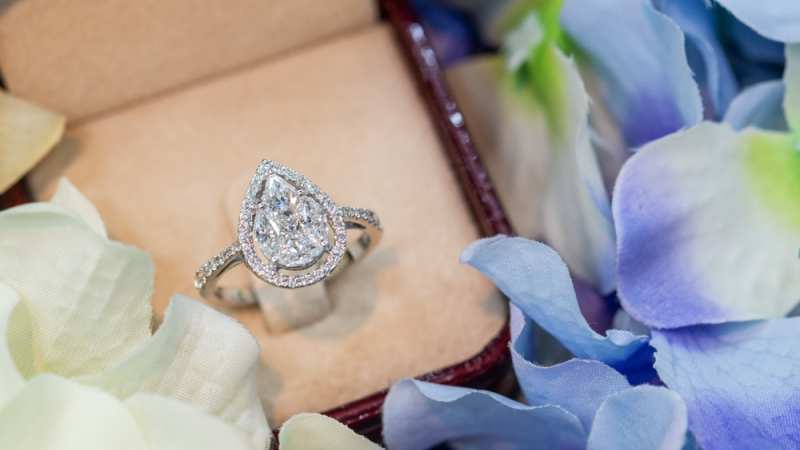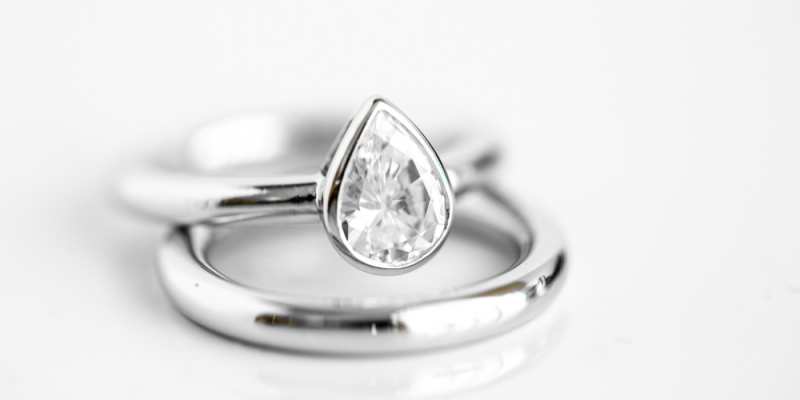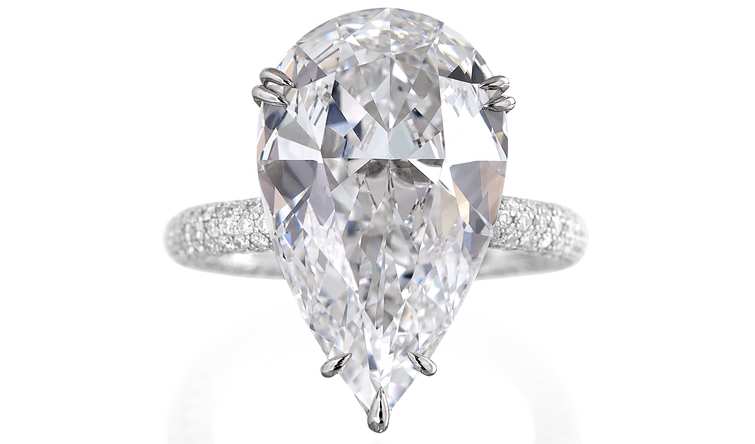Pear-shaped diamonds are renowned for their beauty, elegance, and distinctive appearance. This unique diamond shape is a wonderful option for those seeking something exquisite yet slightly unconventional.
Pear-shaped diamonds are highly sought after for a variety of jewelry pieces.
When used in a diamond pendant, the size of a pear-shaped diamond gracefully enhances the neckline. Placing pear-shaped gems in a ring can create the illusion of slender fingers.
But how can you determine which pear-shaped diamond is the perfect choice for you? In this article, we will provide you with all the essential information you need to know before purchasing a pear-shaped diamond, enabling you to select the one that will truly capture your heart.
DESIGN YOUR OWN ENGAGEMENT RING: START WITH A SETTING OR START WITH A DIAMOND. IT’S REALLY UP TO YOU!

Diamond’s Cut Vs. Diamond’s Shape
Although the terms “diamond shape” and “diamond cut” are sometimes used interchangeably, they actually represent distinct concepts.
Diamond cut is one of the 4Cs used to assess a diamond’s quality. It involves the precise arrangement of facets and proportions within the diamond, taking into account principles of mathematics, physics, and geometry. The cut determines how well the diamond interacts with light, influencing its brilliance and overall visual appeal.
For example, a heart-shaped diamond can be cut too deep or too shallow, affecting its ability to reflect light and resulting in either a dazzling or dull appearance. However, regardless of the cut quality, the diamond will still retain its heart shape.
This distinction may either dampen or pique your interest, but it significantly impacts the beauty of your diamond.
On the other hand, diamond shape is typically the primary consideration for most individuals when choosing a diamond engagement ring. It refers to the external outline or form of the stone.
For instance, heart-shaped, round brilliant, and pear-shaped are all examples of diamond shapes, indicating the overall appearance and contour of the diamond.

What Is A Pear-Shaped Diamond?
A customized pear-shaped diamond with a brilliant cut combines the features of both a round and a marquise shape, featuring a tapered tip on one end.
Essentially, the pear-shaped diamond has a rounded and broader end that is cut in a manner similar to a round brilliant gem, while the narrower portion of the diamond resembles a marquise shape.
This unique shape, along with the oval and marquise cuts, is available in various proportions, ranging from broad to narrow. One advantage of the pear-shaped diamond is that it creates an illusion of longer and slimmer fingers when worn.
The pear-shaped diamond consists of five distinct sections, extending from the rounded edge to the pointed tip:
- The oval end: This is the rounded part of the diamond.
- The shoulder: It is a gracefully curved section that connects the head (top) to the belly (midsection).
- The belly: This is the narrowing core of the pear-shaped diamond.
- The wing: It refers to the portion that tightly joins together to meet the tip.
- The point: This is the sharp and pointed tip of the pear-shaped diamond.

The History Of A Pear-Shaped Diamond
The origins of the pear-shaped diamond can be traced back to the late 1400s, when Flemish gem cutter Lodewyk van Berquem introduced it. Prior to this, Van Berquem had also invented the diamond polishing machine known as the “scarf,” which revolutionized the industry by enabling symmetrical facet placement in diamonds. This breakthrough laid the foundation for the intricate and captivating diamond shapes we admire today.
Initially, the pear-shaped diamond did not gain much popularity. However, its fortunes changed when a well-known Hollywood couple helped elevate its status. In 1969, Richard Burton gifted Elizabeth Taylor a remarkable 69.42-carat pear-shaped diamond, which became famously known as the Taylor-Burton Diamond. This iconic stone became one of the most celebrated pieces in Taylor’s extensive jewelry collection.
Following this significant event, the pear-shaped diamond experienced a surge in popularity and remained fashionable throughout the twentieth century. In recent years, this elegant shape has seen a resurgence in demand, particularly among individuals seeking a distinctive and unconventional expression of their individuality in engagement rings.

How To Pick A Pear-Shaped Diamond
Now that you have an understanding of what a pear-shaped diamond is, let’s delve into what to consider when purchasing one.
Symmetry:
Symmetry plays a crucial role in pear-shaped diamonds. Ideally, look for diamonds with very good or excellent symmetry. The point should align with the curved end’s apex, and the wings, shoulders, and top and bottom curvature should exhibit symmetrical curves without sharp edges. The oval top should appear semi-circular rather than narrow or squat. Assessing symmetry involves imagining a vertical line down the center of the diamond and ensuring the forms on either half mirror each other. Avoid diamonds with noticeable asymmetry, as they may appear crooked or “off.”
Proportions:
Unlike symmetry, there is no universally optimal width-to-length ratio for pear-shaped diamonds. The dimensions are largely a matter of personal preference. Pear-shaped diamonds can be longer and thinner or shorter and broader. The length-to-breadth ratio determines the overall shape, and a ratio of 1.40 to 1.70 is often favored for a traditional pear-shaped look. However, the proportion you choose ultimately depends on your preferences and the intended setting for the diamond.
Bow-Tie Effect:
Pear-shaped diamonds commonly exhibit a bow-tie effect, which appears as a darkening region in the middle of the stone with a bow-tie shape. The visibility of the bow-tie effect can vary significantly. Look for an excellently cut pear-shaped diamond with a minimal bow-tie appearance to avoid a prominent bow-tie effect.
Color:
Color evaluation for pear-shaped diamonds is subjective. However, it’s worth noting that any color hue will be more noticeable in pear-shaped gems compared to oval or marquise cuts. A color grade of G or higher will generally appear best in platinum or white gold settings. Larger pear-shaped diamonds may exhibit slightly darker hues towards the tip. If you prefer a yellow gold or rose gold setting, you may opt for a lower color grade (such as I) to achieve a balanced and beautiful look.
Clarity:
Clarity evaluation for pear-shaped diamonds is also subjective. The cutting technique and shape of pear-shaped diamonds make it easier to achieve eye-clean clarity, with the faceting technique hiding imperfections. However, avoid placing larger inclusions near the diamond’s tip, as it is the weakest point and more susceptible to damage.
Carat:
The carat weight of pear-shaped diamonds varies based on their cut proportions, and linear adjustments in carat size and dimensions may not always be possible. As a result, diamonds with similar dimensions but slightly different carat weights may have similar shapes. A diamond weighing slightly less than a whole carat may be slightly less expensive but appear slightly larger due to its larger dimensions.
By considering these factors of symmetry, proportions, bow-tie effect, color, clarity, and carat, you can make an informed decision when purchasing a pear-shaped diamond that aligns with your preferences and desired aesthetic.

The Best Setting For A Pear-Shaped Diamond
Although not the most common diamond shape, the pear shape brings a unique touch to an engagement ring and looks beautiful on any finger.
However, the pear shape can be delicate due to its single sharp tip, which can catch on objects and potentially chip off.
Selecting the appropriate setting for your pear-shaped diamond is crucial in showcasing its beauty while ensuring its security.
Halo, prong, and bezel settings are popular choices for pear-shaped diamonds. Among them, the prong setting is highly recommended as it provides reliable support and protection for the diamond.

Prong Setting
Prongs are metal claws that hold a diamond securely in place on a setting. The advantage of prong settings is that they allow maximum light reflection, showcasing the diamond’s brilliance without obstruction.
The number of prongs affects both the security and visibility of the diamond. More prongs provide enhanced security but may make the diamond less visible.
One potential issue with prong settings is that over time, the prongs can become flexible or even break as the metal wears down or experiences impacts. It is important to have a jeweler regularly inspect the quality of your prong setting.
For pear-shaped diamonds, the average number of prongs is 5 or 6. To protect the vulnerable point of the pear shape, a V-shaped tip is often added. This V-tip offers the highest level of security for the teardrop-shaped diamond, safeguarding the tip from exposure.
A setting with six prongs and a wide V-tip provides excellent security for a pear-shaped diamond. The number of prongs, whether four or eight, can also impact the overall appearance of the ring.
Furthermore, while a 4-prong setting reveals more of the stone and its sides, a 6- or 8-prong setting can emphasize the symmetry and curves of the diamond for maximum effect.
Smaller stones with fewer than five prongs can be acceptable, but for larger stones, it is advisable to have more prongs to prevent the diamond from accidentally fracturing or slipping out of the ring.
Prong settings are ideal for showcasing your pear-shaped diamond and allowing it to take center stage. The setting can be kept simple or adorned with accent stones and intricate details for a more elaborate look.

Conclusion
It’s undeniable that pear-shaped diamonds are experiencing a significant resurgence, and the reasons behind their popularity are clear. So, what makes pear-shaped diamonds a great choice?
These exquisite teardrop-shaped diamonds are not only timeless and captivating, but they also create a more flattering look. The tapered shape of these gems offers a subtle slimming effect on the finger.
Unlike round diamonds, pear-shaped diamonds are not bound by strict regulations, allowing you to choose proportions that suit your preferences and style.
Moreover, pear-shaped diamonds always seem to possess an extra sparkle compared to other shapes, regardless of their size.


